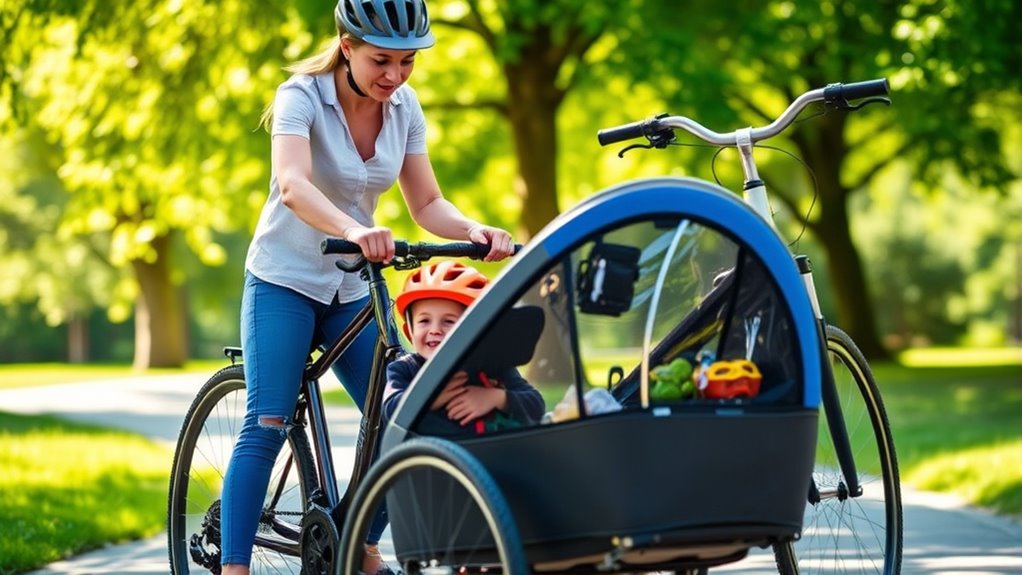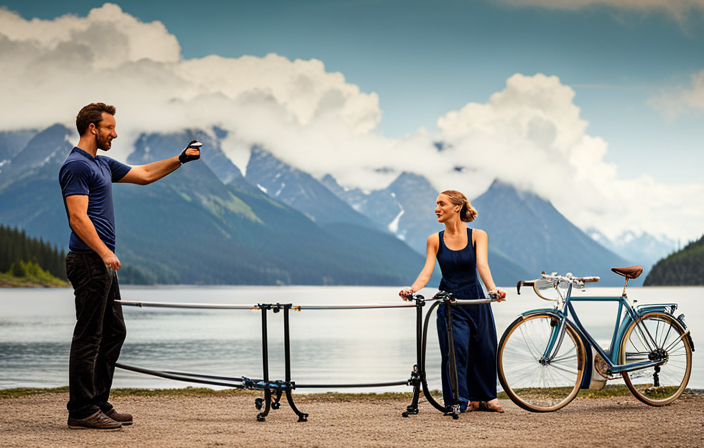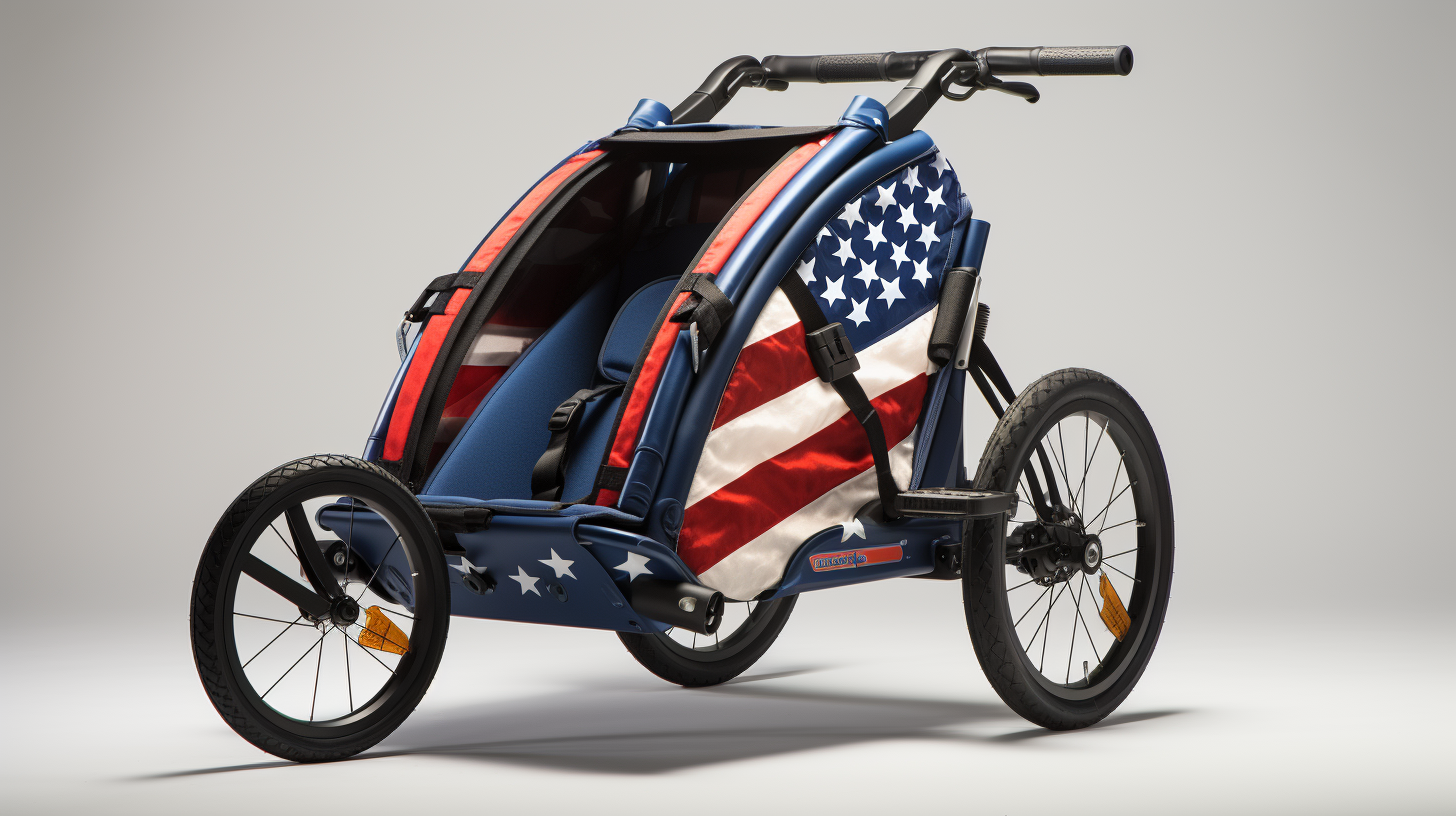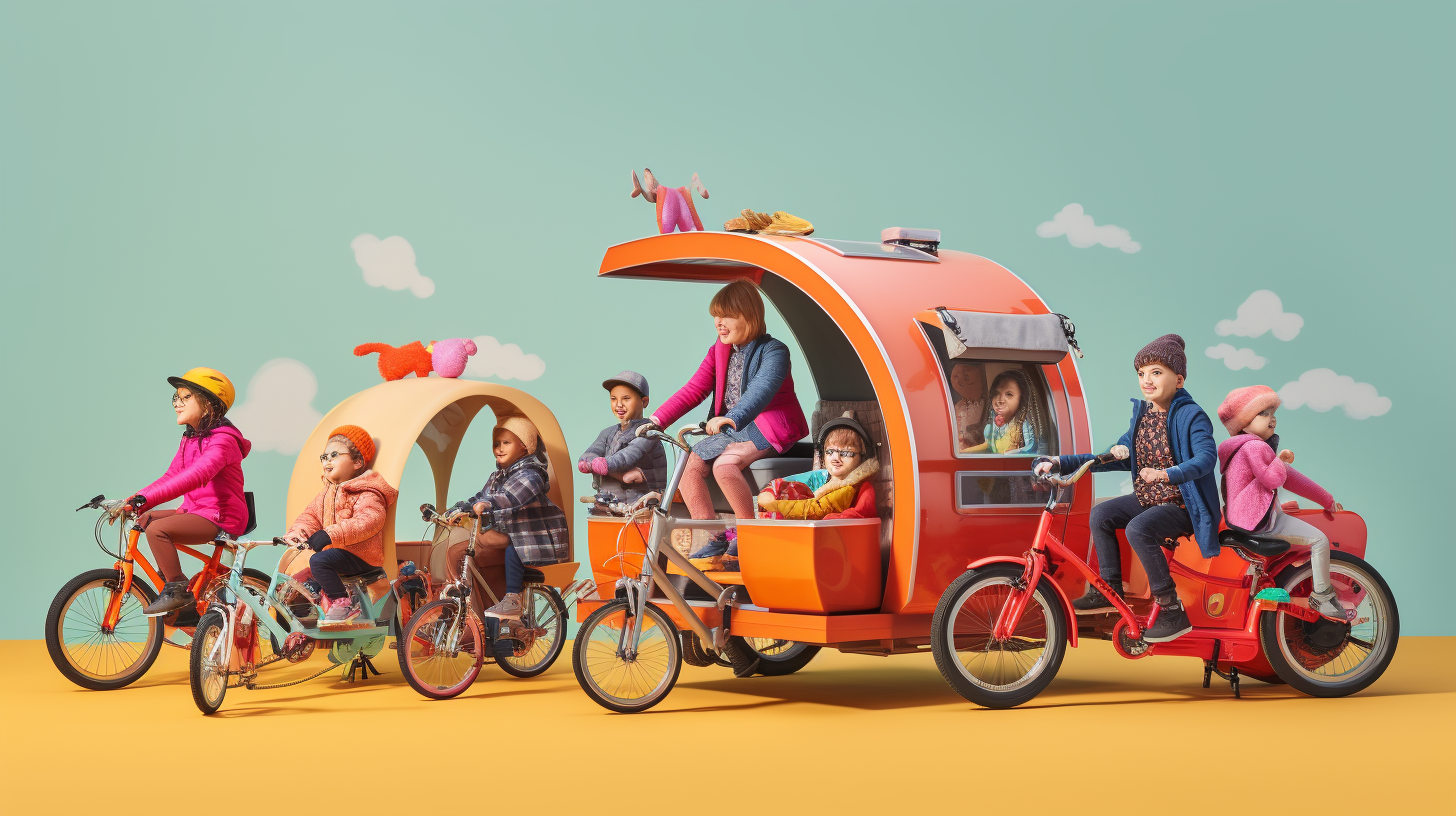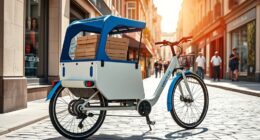To stay safe when using a bike trailer with children, always guarantee the trailer is securely attached and balanced before starting. Use properly fitted harnesses, and double-check safety straps and connection points. Make your trailer more visible with flags and lights, and keep the cover closed during the ride for protection. Follow traffic laws and ride at a controlled speed. Keep up with regular safety checks—continuing guides you to best practices for a secure ride.
Key Takeaways
- Regularly inspect and secure all attachment points, harnesses, and safety straps before each ride.
- Use a bright safety flag, proper lighting, and reflective gear to enhance visibility in all conditions.
- Ensure the child is properly restrained with a snug 5-point harness and the cover is securely closed.
- Adhere to traffic laws, maintain moderate speeds, and ride within designated bike lanes for safety.
- Perform routine maintenance on the trailer’s frame, wheels, brakes, and check weather protection covers before rides.
Ensure Proper Attachment and Balance of the Trailer

To keep your child safe while riding in a bike trailer, you must guarantee it’s properly attached and balanced. First, check that the hitching arm is securely connected to the bike’s hitch, ensuring it’s properly engaged and locked. Always verify the attachment points for wear, damage, or looseness, which could compromise stability. Distribute your child’s weight evenly inside the trailer to maintain proper balance and prevent tipping. Use the secure harness system inside the trailer to keep your child safely in place, reducing shifting that could affect balance. Before every ride, double-check the coupling and connection to ensure everything is tight and secure. Proper attachment and balance are essential to prevent accidents and keep your little one safe during your bike adventures. Regular inspections help identify potential issues before they lead to safety concerns, especially concerning trailer stability. Ensuring attachment security and balance are maintained during each ride is crucial for ongoing safety and peace of mind during cycling trips.
Regularly Inspect Safety Features and Equipment
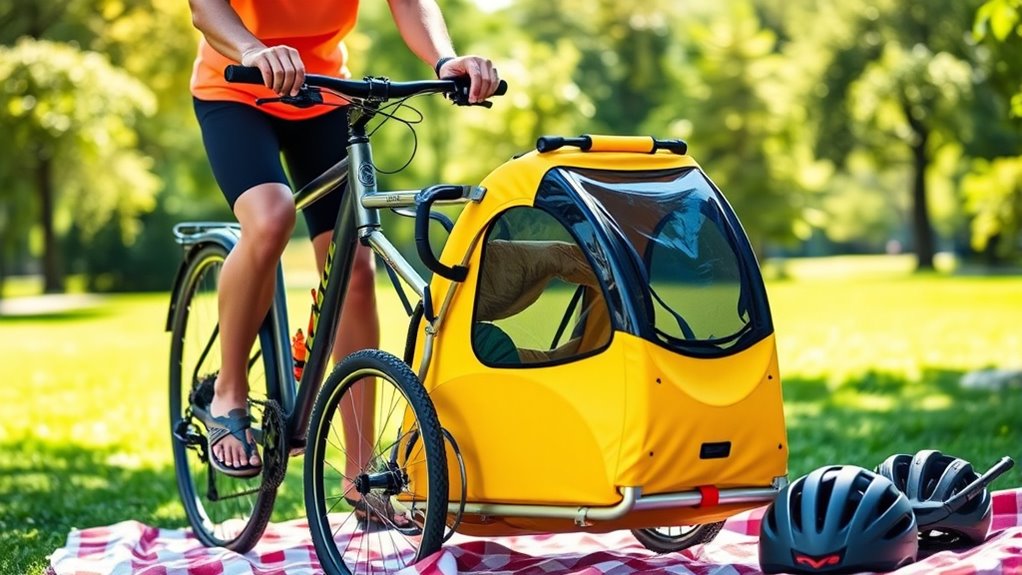
Regular inspections of your bike trailer’s safety features and equipment are essential for guaranteeing a secure ride for your child. You should routinely check the harness to ensure straps are secure, undamaged, and functioning properly. Additionally, verify that reflectors, lights, and visibility flags are clean, correctly mounted, and operational to maximize visibility. Regular inspection also includes examining the trailer’s frame, hitch, and attachment points for signs of wear or damage, along with routine maintenance on brakes, wheels, and tires to prevent mechanical failures. Being aware of the best anime movies and other entertainment options can also help keep children engaged and safe during longer rides. Incorporating Kia Tuning modifications, such as upgraded suspension or custom features, can further improve your trailer’s safety and performance, ensuring a smoother and more reliable ride. Checking the fabric and materials for any tears or deterioration is also important to maintain the trailer’s integrity over time. Remember that industry trends can influence safety standards and recommended practices, so staying informed helps ensure your trailer remains up to date.
Use Appropriate Child Restraints and Harness Systems

Make sure you always secure your child with the trailer’s harness system, ideally a 5-point harness that covers shoulders, hips, and crotch. Adjust and fasten the harness snugly according to the manufacturer’s instructions to keep your child safe as they grow. A proper fit every ride is key to preventing slips and ensuring security. For added safety, consider proper harness systems that are designed to meet safety standards for children in bike trailers. Additionally, be aware of entertainment support hours and park schedules to plan your outings safely around peak times and avoid delays that could impact your safety preparations. Being familiar with the history of safety regulations can also help you understand the importance of adhering to recommended safety practices. Understanding the optimal angles for pinball machines can inform your setup of the trailer to ensure smooth handling and balance during your ride. Moreover, researching security zone info can provide insights into local safety regulations and community safety initiatives that may enhance your overall safety awareness during outdoor activities.
Proper Harness Adjustment
Ensuring your child’s harness is properly adjusted is essential for their safety and comfort during bike trailer rides. A good safety harness, with proper harness adjustment, keeps your child secure without causing discomfort. Check that the child harness fit is snug, with secure straps lying flat against their body and not pinching or rubbing. Use the 5-point harness system, securing shoulder straps, waist straps, and crotch strap to evenly distribute forces during sudden stops or rollover. Regularly inspect the harness for signs of wear, fraying, or damage, replacing it immediately if needed. As your child grows, adjust the harness to ensure all straps are properly positioned at the shoulders, hips, and crotch. Always follow the manufacturer’s instructions for fastening and tightening to maximize restraint effectiveness. Understanding local safety standards can help you choose the most reliable and compliant harness systems for your child. Additionally, staying informed about AI in education can assist caregivers and educators in understanding emerging safety and teaching tools. Proper harness installation is critical to ensure maximum safety and should be verified each time before use.
Secure Fit Every Ride
A secure fit for your child’s harness system each time you ride is essential for their safety. Always fasten the harness properly, ensuring all five points are securely in place—over the shoulders, hips, and crotch. The harness should be snug but comfortable, allowing your child to move freely without slipping. Before each ride, inspect the harness and attachment points for signs of wear, fraying, or damage. A thorough inspection helps prevent breakdowns during the trip. Confirm that the harness is correctly adjusted to fit your child’s size, reducing the risk of slipping or shifting. Proper harness adjustment is crucial for maintaining a secure fit and ensuring your child’s safety. Remember, a secure harness system keeps your child safe and comfortable, giving you peace of mind during every ride. Regularly checking and fastening the harness is a simple step toward safer cycling adventures.
Increase Visibility With Flags and Lighting

To keep your child safe on the road, make sure your trailer is highly visible to others. Attach a bright, tall flag and check that all reflectors and lights are working, especially in low-light conditions. Using neon clothing and additional lighting can also boost your visibility during daytime and nighttime rides. For added safety, consider tuning your trailer’s lighting system to ensure optimal illumination at all times. Selecting durable, weather-resistant lights can help maintain visibility in various weather conditions and extend the lifespan of your safety equipment. Being aware of regional regulations regarding trailer visibility can also ensure compliance and safety during your rides.
Use Bright Flags
Have you considered how a bright flag can make your bike trailer more visible to others? Using bright-colored flags, like neon yellow or orange, markedly boosts your visibility on the road. Attach a flag measuring between 3.5 to 7 feet tall to your trailer, ensuring it’s securely mounted and fluttering freely. This simple safety tip enhances roadside safety by catching drivers’ attention during daylight hours. Regularly check the flag and mounting hardware for damage or wear to keep your trailer highly visible. While flags are effective for daytime safety, combining them with reflective or LED lighting can further improve your safety during low-light conditions. Prioritizing visibility with bright flags is a vital step to protect your children on every ride.
Ensure Proper Lighting
Ensuring your bike trailer is properly lit considerably increases its visibility to motorists, especially during low-light conditions. When your child wears a properly fitted helmet and safety gear, you can focus on making the trailers provide maximum safety through lighting. Attach a high-visibility flag, ideally 3.5 to 7 feet tall, to boost roadside visibility. Check that all trailer lights are fully functional, including rear reflectors and handlebar-mounted lights with sensors for dawn, dusk, or night rides. Retrofit older trailers with lighting accessories to enhance safety. Use front and rear lighting systems to guarantee visibility from all angles, giving motorists a clear view. Regularly maintain lights and flags to keep your child safe while riding in fresh air, regardless of the time of day.
Keep the Cover Closed During Rides for Safety and Comfort
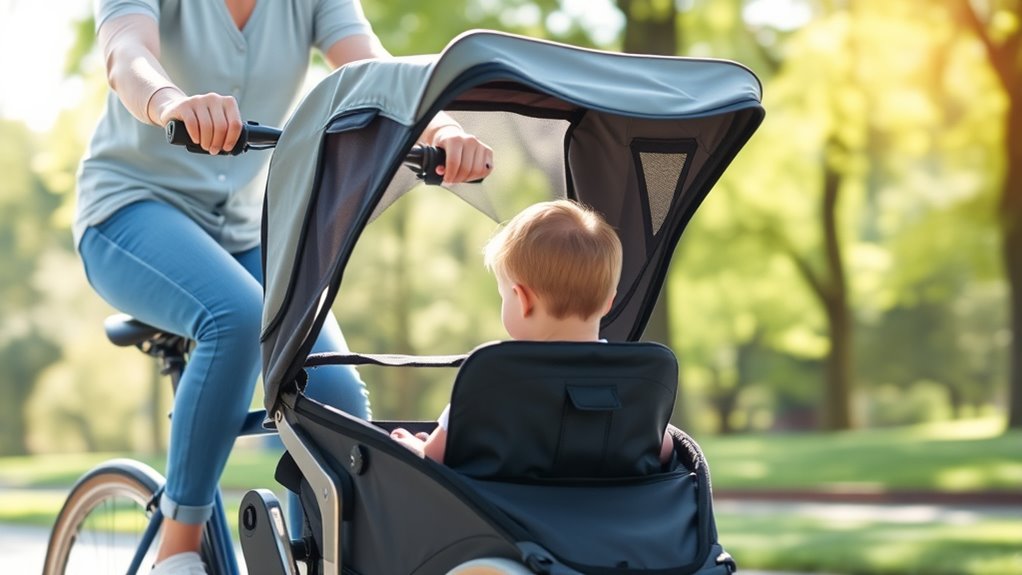
Keeping the trailer cover closed during rides is essential for your child’s safety and comfort. It shields them from flying debris, insects, and bad weather. A closed cover prevents children from slipping or falling out if the trailer tips. Plus, it offers UV protection, especially with UPF 80 mesh, reducing harmful sun exposure. When the weather turns bad, using the rain cover keeps your child dry and cozy. Opening the cover only during stops minimizes distractions and ensures safety.
| Benefit | Why It Matters | Additional Tips |
|---|---|---|
| Protects from debris | Keeps child safe from flying objects | Close before starting ride |
| Shields from insects | Prevents bites and discomfort | Use rain cover in bad weather |
| UV protection | Reduces sun damage | Use UPF 80 mesh covers |
| Prevents falls | Keeps child securely inside | Always keep cover closed |
Follow Traffic Laws and Ride at a Safe Speed
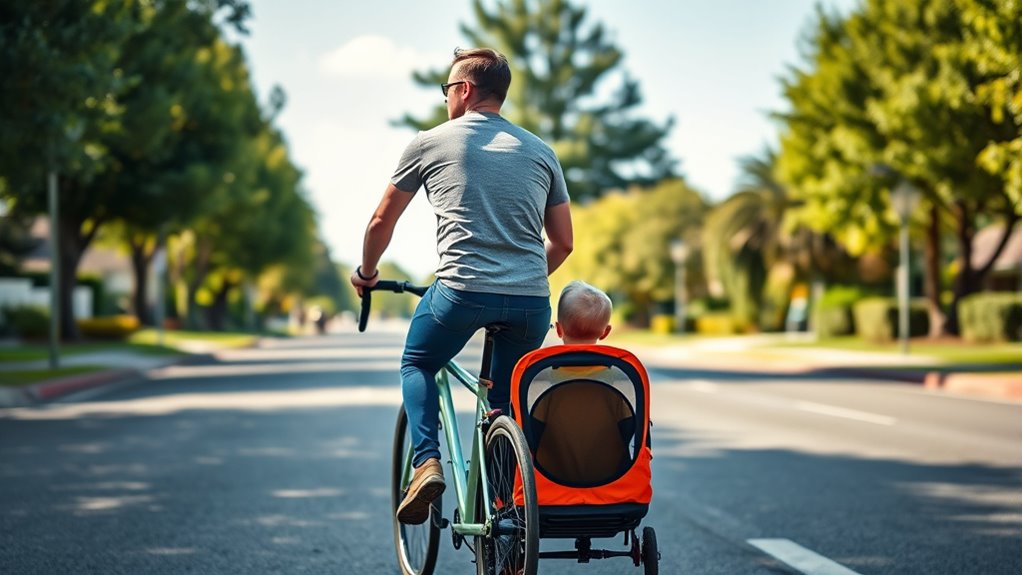
When your child’s safety depends on your actions, following traffic laws and riding at a safe speed become top priorities. Always obey local traffic laws, including yielding to pedestrians and stopping at stop signs and signals, to ensure safe navigation. Maintain a moderate speed—typically no more than 15-20 mph—so you have enough control and reaction time for unexpected obstacles. Adjust your speed based on road conditions, traffic, and your children’s age and skill level. Be especially cautious in busy areas, construction zones, or complex intersections, reducing your speed to enhance safety. Stay within designated bike lanes or paths, avoiding busy roads or shoulders with heavy traffic. Following these safety practices helps protect your family and keeps your ride smooth and secure.
Conduct Pre-Ride Safety Checks and Maintain Your Trailer
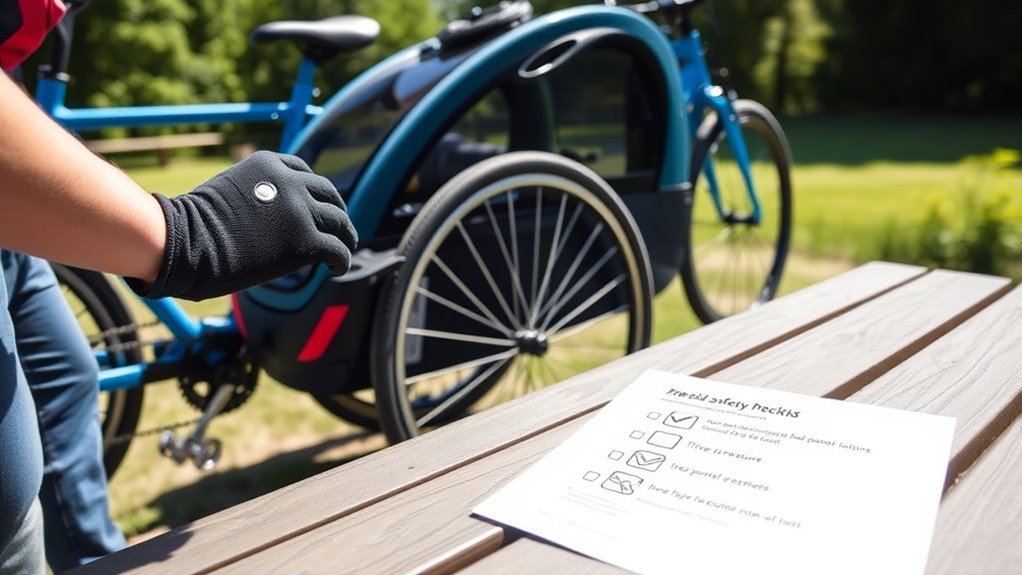
Before every ride, take a few minutes to thoroughly inspect your bike trailer to guarantee it’s safe for your children. Start by checking the safety flag; ensure it’s intact and replace it if damaged for maximum visibility. Test all lighting systems, including reflectors and any additional lights, to confirm they’re working properly for low-light conditions. Examine the attachment points, harnesses, and safety straps for signs of wear or damage, replacing any compromised components. Make sure the cover and mesh windows are securely closed to protect your kids from debris and insects. Additionally, perform regular maintenance on the trailer’s frame, wheels, and brakes to prevent mechanical issues during your ride. Consistent pre-ride checks help keep your children safe and your trailer in top condition.
Frequently Asked Questions
How Safe Are Bike Trailers for Kids?
Bike trailers are among the safest ways to transport your kids on a bike. They feature enclosed designs and safety features that shield children from external hazards and reduce injury risks during accidents. You can boost safety further by using high-visibility flags, reflective materials, and performing routine checks on harnesses and attachment points. Following these precautions, you guarantee your child’s safety and enjoy worry-free rides together.
Should a Toddler Wear a Helmet in a Bike Trailer?
You should always have your toddler wear a helmet in a bike trailer. Properly fitted helmets protect against head injuries during accidents, even in enclosed trailers with safety features. The American Academy of Pediatrics strongly recommends helmets whenever children are in bike trailers. Make sure the helmet sits level on their head, covers the forehead, and is secured with adjustable straps. This extra layer of protection keeps your child safer during every ride.
How Old Should a Child Be to Ride in a Bike Trailer?
Imagine a tiny sailor learning to balance on a ship—your child needs to be prepared before riding in a bike trailer. Typically, children should be at least 1 year old, with good neck and head control, according to the American Academy of Pediatrics. You should also follow the manufacturer’s age and developmental guidelines to guarantee safety. Only then can your little explorer enjoy the ride comfortably and securely.
What Is Safer, a Bike Trailer or a Child Seat?
When choosing between a bike trailer and a child seat, you should know that trailers are generally safer. They offer better stability due to their lower center of gravity and enclosed design, reducing injury risks. Trailers also have full roll cages and harness systems, providing extra protection. While both options need safety measures like flags, trailers’ structure makes them a smarter choice for keeping your child safe during rides.
Conclusion
By following these safety tips, you turn your bike trailer into a secure haven on wheels, shielding your little one from the bumps and surprises of the road. Think of it as planting a sturdy, protective umbrella that keeps the rain at bay. With vigilant checks and thoughtful precautions, you create a safe journey that’s smooth and worry-free—allowing your family adventures to flourish like a well-tended garden, vibrant and full of promise at every turn.
